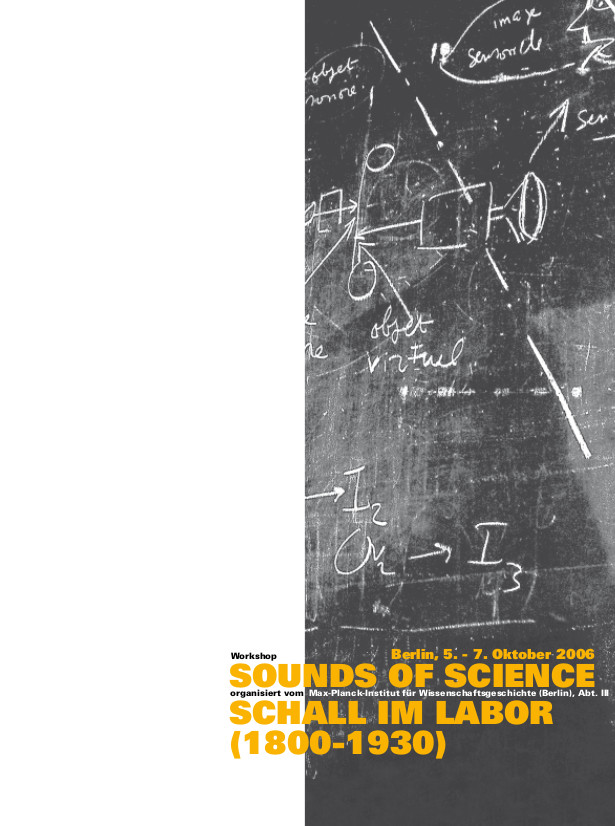Julia Kursell (ed.): Sounds of Science – Schall im Labor, 1800–1930 (2008) [English, German]
Filed under proceedings | Tags: · acoustics, aesthetics, history of science, music, radio, science, sound

The following collection of papers documents the workshop Sounds of Science – Schall im Labor, 1800 to 1930, carried out at the Max Planck Institute for the History of Science, Berlin, in October 2006.
The workshop asked about the role sound plays in the configurations among science, technology and the arts, focusing on the years between 1800 and 1930. The chronological point of departure was the appearance of a registration technique: in 1802 Ernst Florens Friedrich Chladni published his book on acoustics where he extensively described the Klangfiguren – his visualizations of the movements of a vibrating, sounding body. This time span was also characterized by the systematization of research into hearing, which Hermann von Helmholtz greatly promoted through his book On the Sensations of Tone as a Physiological Basis for the Theory of Music, which first appeared in 1863. Helmholtz’s resonance theory of hearing described in this book was not replaced by a new explanation for the process of hearing until the end of the 1920s, which gives another temporal delineation for the workshop. Furthermore, between 1800 and 1930 a wealth of technical innovation in the realm of acoustical media occurred: in addition to a series of visualization techniques for sound, the phonograph and gramophone, microphone and loudspeaker, telephone and radio were invented. As well, the music of European tonal composition underwent a radical change during this time that led to a collapse of the tonal system and provoked the demand for music composed of sounds and noises, rather than tones.
Conference participants were invited to discuss the role of sounds in the laboratory from different angles, in three parts. The “Materiality of Sound” was oriented towards research into material cultures and cultural techniques in experimentation. “Registration, Transmission, Transformation” put questions of medial historiography into the foreground, while “Experimental Aesthetics” thematized aesthetic implications.
With papers by Bernhard Siegert, Peter Szendy, Julia Kursell, Florian Hoelscher, Florian Dombois, Henning Schmidgen, Jonathan Sterne, Wolfgang Hagen, Douglas Kahn, Daniel Gethmann, Elena Ungeheuer, and Myles W. Jackson.
Publisher Max-Planck Institute for the History of Science, Berlin, 2008
MPG Preprint 346
Open Access
134 pages
PDF (15 MB)
Comment (0)Esther Leslie: Synthetic Worlds: Nature, Art and the Chemical Industry (2005)
Filed under book | Tags: · aesthetics, art, chemistry, history of science, industry, nature, science

Synthetic Worlds considers the remarkable alliance between chemistry and art, taking us from the late eighteenth century to the period immediately following the Second World War. Esther Leslie offers fascinating new insights into the place of the material object and the significance of the natural, the organic, the inorganic and the synthesized in this poetics of science.
Through its dazzling innovations, which began in the nineteenth century, chemistry has granted new colours and surfaces, new substances, coatings and textures to the world. Often they are the result of accidents or the by-products of pollution. Chemistry has also invented simulants and surrogates for naturally occurring materials. Sometimes these developments confounded earlier alchemical and Romantic philosophies of science and nature, but, at other times, dynamic theories of chemical action combined with the emergent chemistry textbook orthodoxy. For example, the colour wheels of Goethe and Philipp Otto Runge, Hegelian theories of a spirit that inhabits dyes and ‘drives’ materials, and Romantic ideas of the weddings of substances influenced the experiments that boosted the successful German chemical industry after the 1840s. In turn, chemistry’s discoveries seeped back into philosophy and art.
Esther Leslie’s Synthetic Worlds considers this and other startling affinities between chemistry, industry, aesthetics and art. Themes include the impact of artificial imitations and synthetics, the location of value, the mutability of substance, chemical fragility and artistic technique, the poetics of the inorganic and pollution, Bauhaus-influenced modulation and patina in art practice, and nationalist narratives of chemical breakthrough.
Publisher Reaktion Books, 2005
Art, Industry and Industrial Studies series
ISBN 1861892489, 9781861892485
280 pages
review (Sophia Efstathiou, Hyle)
Comment (0)Journal of Neuro-Aesthetic Theory, No 1-5 (1997-2011)
Filed under e-zine | Tags: · aesthetics, architecture, art, biopolitics, brain, cinema, cognition, cognitive capitalism, curating, film, mind, neuroaesthetics, neurobiopolitics, philosophy, science, theory
Journal of Neuro-Aesthetic Theory #5 (2007-11)
Neurobiopolitics, Pluripotentiality and Cognitive Capitalism, a work in progress…
View online (HTML articles)
Journal of Neuro-Aesthetic Theory #4 (2005-07)
Conference of Neuroaesthetics
View online (HTML articles)
Journal of Neuro-Aesthetic Theory #3 (2003-04)
Buildings, Movies and Brains.
View online (HTML articles)
Journal of Neuro-Aesthetic Theory #2 (2000-02)
Cinema and the Brain
View online (HTML articles)
Journal of Neuro-Aesthetic Theory #1 (1997-99)
Introduction to Neuro-Aesthetic Theory
View online (HTML articles)
Contributors: Warren Neidich, Charles T. Wolfe, Andrew Patrizio, Philippe Rahm, Meena Alexander, Michael Madore, Martina Wicklein, Martina Siebert, Norman M. Klein, Michael Salcman, Nicholas Wade, Nicholas Chase, Nathalie Angles, Martha Trivizas, Nicola Diamond, Mark Cohen, Lev Manovich, Laura U. Marks, Lucy Steeds, Mark Bishop, Olafur Eliasson, Margarita Gluzberg, Marcos Novak, M. A. Greenstein, Marquard Smith, Paul D. Miller -DJ Spooky, Vivian Sobchack, W. H. Zangemeister, Thyrza Goodeve, Warren Sack, Zoe Beloff, Yann Beauvais, William Hirstein, Stuart Brisley, Peter Brugger, Ralph Greenspan, Penny Starfield, Kodwo Eshun, Sarat Maharaj, Scott Lash, Steven Holl, Karen Beckman, Colin Gardner, Conerly Casey, Christiane Paul, Chloe Vaitsou, Daniel Blaufuks, Diana Thater, Ken Jacobs, Dennis Balk, David J. McGonigle, Charlie Gere, Armen Avanessian, Arnold H. Modell, Anjan Chatterjee, Andreas Roepstorff, Barbara Marie Stafford, Brian Massumi, Bernard Andrieu, Beau Lotto, Elizabeth Cohen and Michael Talley, John Welchman, Janet Sternburg, Elizabeth S. CohenJonathan Green, Joseph Kosuth, Andrea Grunert, Juli Carson and Lindi Emoungu, Jules Davidoff, Isabelle Moffat, Israel Rosenfeld, Francois Bucher, Eric Duyckaerts, Ellen K. Levy and David E. Levy, gruppo A12 and Francisca Insulza, Gregg Lambert and Gregory Flaxman
Initiated by Warren Neidich
Comment (0)
